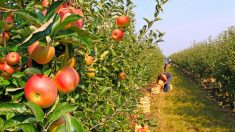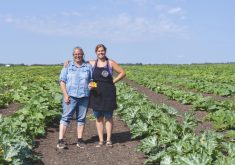Have you ever thought there might be an opportunity in knowing what foods will be hot in the next few years? Ever wonder if you should really care?
For our Country Guide readers, I asked Toronto’s Dana McCauley — chef, recipe developer, food trend watcher, and executive director of Food Starter, a non-profit food incubator — to gaze into her crystal ball and tell us what she sees coming down the pipe.
Mainly, she tells us, it’s good news for farmers.
Q. What drives food trends?
Read Also

Are you ready for farm succession?
What motivates some farmers to make a succession plan while others don’t seem worried.
McCauley: There’s a push and a pull. Push usually comes from self-interest, like when the cheese producers push fondue. But what really drives food trends is the pull — that is, what consumers want — when you fill an unmet need. I look to see what’s gaining traction in food service and whether or not there is a parallel in the mainstream. If there isn’t, then there may be a market opportunity there.
Q. How do you quantify food trends?
McCauley: It’s really hard. There is some data but people may not know what they want. Like Henry Ford said, if you had asked people what they wanted they would have said faster horses. It takes good background to understand the gap between intentions and actions. People tend to overestimate how much interest they have in trying something. Trend data is directional, but the numbers are only significant when they are very big or very small.
Q. So the million-dollar question… what’s going to be hot in the next few years?
McCauley: I think the interest in Canadiana and homegrown will be strong. With the Pan Am games in 2015, a strong performance at the 2016 Olympics and now we’re moving into the sesquicentennial (Canada’s 150th birthday), there’s a lot of patriotism.
The local food movement has laid the groundwork. Red and white food and hometown classics like regional dishes will be hallmarks in 2017. This is great news for ag if you want to move up the value chain.
There is a distrust of science so people are more interested in eating like their ancestors. Nutrition science has flip-flopped. In the 1990s the focus was on eliminating fat. Now that science has proven that dietary cholesterol is not as bad as they once thought, there is a celebration of whole foods like butter and eggs, and an uptick in butter and egg sales. Sales for squeeze cheese and margarine are falling off. Unfortunately, this distrust of science also leads to fears about GMOs.
Q. What trends are dying?
McCauley: I wish I could say the Extreme Eating trend was dying. There’s a yin and a yang with eating patterns. While there is a trend to eating smaller portions and more vegetables, there is also the shock value of eating insects.
The trend towards massive portions, conspicuous consumption and wastefulness is dying. Mainstream grocers are joining the “ugly fruit and vegetables” movement.
Q. What about bacon?
McCauley: The bacon trend has faded a bit. There is bacon fatigue but it will continue to be out front and centre for the next little while as part of the “hoser culture” I mentioned earlier. Bacon is still popular with the teens and early 20-somethings, a kind of teenaged rebellion.
Q. What do you see as far as generational influences?
McCauley: We see a lot of emphasis on Millennials in marketing but, sadly, the poor Millennials graduated with a lot of debt, are not getting full-time jobs with benefits, and now they are having kids so they don’t have a lot of money. They are looking for value. They are Walmart and No Frills shoppers but they also want organic milk from a local cow. They are a tough group to make money on.
On the other hand, the Boomers are asset rich. It’s smarter to focus on them. They are interested in products that help them to feel good and live longer, like functional foods for joint health or cancer prevention. They also entertain a lot and will pay extra for “water cooler-worthy” foods.
For Gen Z (the generation after the Millennials) it’s all about speed, having things right now and gamifying things. They use technology to pre-order and to get delivery.
Pokemon is just the first generation of its type, and businesses that can figure out how to use this type of marketing will benefit. I don’t think they are going to outgrow tech.
Q. What about the trend of eating exotic meats?
McCauley: I think that there will be small growth in exotic non-native meats such as emu if they offer significant health benefits over other protein choices. The potential for growth in native species (duck, venison, rabbit) is much higher as we see Canadians reflecting on our heritage and feeling proud of being Canadian in the wake of the Pan Am Games and Olympics and in anticipation of Canada’s 150th celebrations.
Q. What’s your prediction on whether vegetarian/vegan eating will increase or decrease?
McCauley: I see it definitely increasing. As movements such as meatless Monday and the foodservice offering of meatless options improves, more people are finding it normal to eat non-meat dishes on occasion. That said, 100 per cent veganism is not likely to become the norm, but more people who generally are carnivores will begin to eat meatless foods as part of their regular repertoire.
Q. What about interest in animal welfare and/or certified humane farming methods?
McCauley: There will be lots! Research shows that failed and/or lapsed vegetarians convert very strongly to humane animal products when they return to meat eating.
Q. What about organic food?
McCauley: Organics remain a strong category especially with Millennial moms who want to give their kids a strong start in the world. Most research shows that from the day she is aware of her pregnancy, many young women start eating organic and that they continue until the baby becomes fairly independent. This is also a committed value shopper and you’ll see Costco and Walmart trying very hard to please her with organic products.
Q. Do you have any specific advice for farmers?
McCauley: Agri-tourism is definitely trending up and the Ontario Culinary Tourism Alliance is doing a good job developing the market as with the Butter Tart Trail. Quebec has done the same, especially with maple syrup. Agri-tourism has already been well-established in Europe for many years. For example, people would buy olive oil from Tuscany or cheese and ham from Parma. We are just catching up here and there are huge opportunities for farmers. Lots of tourism departments are getting involved now too.
What’s really important for someone with an established farm is to look longer term. All of the predictions are that our populations are growing not from birth, but from immigration, mostly from the Middle East and Asia. Farmers should look at the demographic predictions. For example, if there are a lot of Muslims moving into your area, learn more about Halal customs.
For more info on food trends, subscribe to Dana McCauley’s Food Trends TV on YouTube.
This article was originally published as ‘Hungry Consumers’ in the November 2016 issue of Country Guide
















